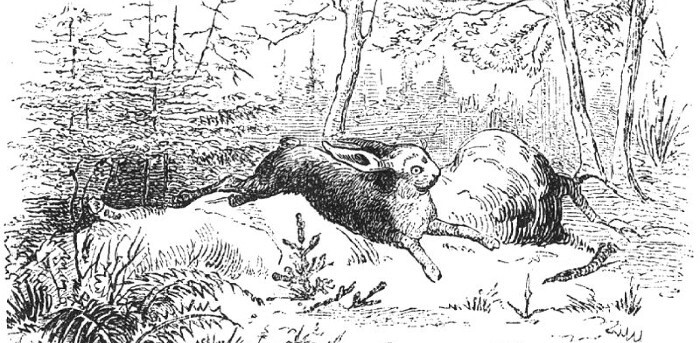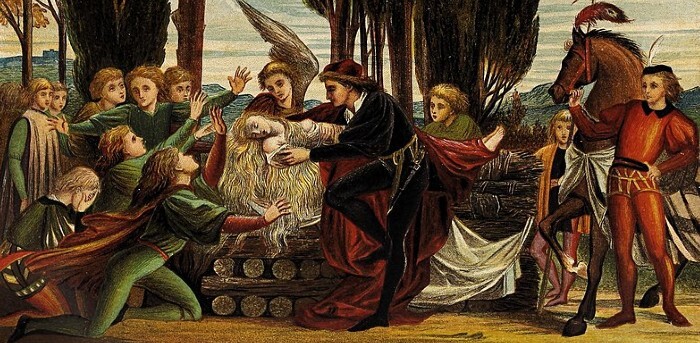15 Hans Christian Andersen Fairy Tales (That Are Messed Up )

Hans Christian Andersen was a beloved short story writer who gave us dozens of modern classics and also one messed up dude. Disney might have rounded off some of his sharper edges, but some of these stories are better fit for the Coen brothers.
The Ugly Duckling

The version you read probably didn’t mention that the Ugly Duckling was driven from the farm after being physically tortured by the other animals and told by his mother that she wished he was never born, right? Or that the only potential friends he found were murdered in front of him? Also, he only realizes what he is after attempting suicide by swan.
The Little Mermaid

(Walt Disney Pictures)
Likewise, the Disney movie left out the fact that the Little Mermaid’s new legs feel like walking on knives. Also, she’ll die if the prince marries someone else, which he does, but because she resisted the offer to kill him in exchange for turning back into a mermaid, she’s instead turned into a “daughter of the air” spirit and told that she can go to heaven if she does 300 years of good deeds. It’s not a great song for a crab.
The Little Match Girl

(Walt Disney Pictures)
This one is exactly as twisted as you remember: A little girl, afraid of going home because she’ll be beaten for not selling enough matches, hunkers down in the cold and lights all the matches one by one to keep warm, experiencing strange hallucinations as she freezes to death. The vision of her dead grandmother carries her to heaven, though, so that’s Anderson’s version of a happy ending.
The Snow Queen
“The Snow Queen” is fairly tame -- except for the part where Gerda, on her quest to rescue Kay from the queen, encounters a gang of robbers, including a little girl who might be part hyena and constantly threatens animals and Gerda with a knife. Weird that Disney didn’t go for this one. Think of all the knives they could sell!
The Snowman
“The Snowman” is a story about -- get this -- a snowman who is obsessed with a wood-burning stove. When he melts, his dog friend notes that the snowman’s body was built around a stove-scraping shovel and that’s probably why he loved it so much, and then “nobody thought any more of the snowman.” That’s it. That’s the whole story.
The Beetle Who Went on His Travels
“The Beetle Who Went on His Travels” follows a beetle who ditches his dung heap in search of stinkier pastures. At one point, he gets married and starts a family, but after realizing that he might have to feed them from time to time, he decides to peace out, leaving his wife a “forsaken widow.” It’s a fairy tale for men’s rights activists.
The Steadfast Tin Soldier

A weird category of Andersen stories involve the adventures of a whimsical anthropomorphic object that is mercilessly destroyed at the end. “The Steadfast Tin Soldier,” for example, is cast out of his person’s home by an evil goblin and bounces around the world before ending up back at home … and then thrown into the fire by the boy who owns him. There’s a semblance of a message in that the soldier melts down in the shape of a tin heart, but still. It’s like if Toy Story 3 hadn’t chickened out.
The Fir Tree

Likewise, the “Fir Tree” longs for nothing more than to grow up and become something useful like a ship mast, and he’s as happy as a cult sacrifice to be cut down and used as a Christmas tree, but then spring rolls around and he’s burned to death. Merry Christmas!
The Pea Blossom

Five peas -- two restless, two lazy, and one annoyingly placid -- from the same pod are loaded into a pea shooter and scattered to the wind, after which the Zen pea becomes a symbol of hope for a sick little girl. Sounds nice, right? Well, it’s revealed at the end that three of the other peas were immediately eaten by pigeons and one of the excitable ones just landed in a dirty gutter, where it swelled with water until it exploded but not before it and the gutter agreed it was “the most remarkable” pea of its pod, so who knows what the hell Andersen was trying to say.
The Girl Who Trod on a Loaf
“The Girl Who Trod on a Loaf” is the bratty ward of a rich lady who has to be cajoled into visiting her impoverished parents, and when she does, she uses the loaf of bread she was supposed to give to them as a stepping stone so she doesn’t get mud on her shoes and gets punished by sinking into a muddy hell. She’s down there for years before she finally repents and gets another shot. Soooo, respect your parents?
The Jewish Girl
That title has probably geared you up for one offensive roller coaster, which is the correct reaction because it’s about a Jewish girl named Sarah who longs to convert to Christianity but her mean old father won’t let her because of a promise he made to her dead mother. She eventually dies and must be buried outside the Christian cemetery, but it’s okay because Christian hymns still reach her grave. The story was actually considered progressive at the time because it was sympathetic to a Jewish character, but Andersen actually dated a Jewish girl named Sara who dumped him after he offered her a job in a castle he was eyeing, so take that as you will.
The Red Shoes

The victim of “The Red Shoes” is punished for wearing her pretty new shoes to church (God is picky about shoe color, apparently) by being cursed to dance literally to death. In desperation, she chops off her feet, but they keep dancing, mostly in front of the church doors so she can’t get in. Finally, she prays, her heart explodes, and she gets to go to heaven. Again, this is a happy ending.
The Wild Swans

After their evil stepmother turns 11 boys into swans, their lone sister escapes and finds out from a fairy queen that she can turn them back if she knits them shirts out of stinging nettles that give her painful blisters. Oh, and if she speaks to anyone before the task is finished, they’ll die. She almost gets burned at the stake as a witch because she can’t explain to anyone what she’s doing until her brothers show up, put on the shirts, and change back, which somehow doesn’t ring any witchy alarms. She couldn’t finish one of the shirts in time, so one of the brothers just has one monstrous swan wing forever.
The Shadow

“The Shadow” starts as a fanciful story about a man losing his shadow, but then the shadow comes back, having become human, starts psychologically breaking down the man, then has him executed after convincing everyone the man is actually his shadow. Did Chuck Palahniuk actually write this story?
Little Claus and Big Claus

There’s a lot going on in “Little Claus and Big Claus,” but it starts with horse murder (after which Little Claus skins his dead horse and cons people by telling them his Bag O’ Horse Skin is a wizard), middles with grandmotherly corpse abuse, and ends with ironic revenge murder via drowning in a sack. This is a lesson about greed somehow. If “The Shadow” is a Palahniuk book, this is a Tarantino movie.
Top image: Thora Hallager/Wikimedia Commons